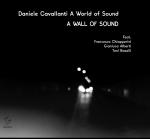

Blessing presents a series of ceremonial music and Buddhist chants of Monks from the Spituk Monastery (Gonpa), situated in Leh (Ladakh, India).
Recorded with the essential help of HCHF – Himalayan Cultural Heritage Foundation - the album displays some of the main instruments of the Tibetan religious music - gyaling (rgya-gling), dungchen (dung), rnga, damaru, bugtsal, silnyan – in instrumental and chanted tracks.
Blessing presents a series of ceremonial music and Buddhist chants of Monks from the Spituk Monastery (Gonpa), situated in Leh (Ladakh, India).
Recorded with the essential help of HCHF – Himalayan Cultural Heritage Foundation - the album displays some of the main instruments of the Tibetan religious music - gyaling (rgya-gling), dungchen (dung), rnga, damaru, bugtsal, silnyan – in instrumental and chanted tracks.
Tibetan culture, and people, is very spiritual and the music is an essential part of this approach to life. Music is fully integrated in the Buddhist ceremonies that mark the various period of the day, of the year, of the life. From the philosophical and spiritual point view, often more than from the aesthetic one, sounds highlight various moments of the religious activities. In the recording you can enjoy a series of short tracks that accompany ceremonies and moment of the day as well as prayers where music and chanting mix in a very typical Tibetan style.
The recording present of group of MONKS FROM THE SPITUK MONASTERY, one of the main Gonpa (monastery) in the entire Himalaya. After the invasion of Tibet by Chinese army, most of the Tibetan spiritual leaders and people had to leave their birth place finding a new house in India. Ladakh, known as small Tibet, where the Tibetan Buddhist has been present for last ten centuries, became one of the natural site for the exiled Tibetans. Spituk Gonpa is one of these important center that preserve the life of the Tibetan Buddhism.
Spituk Monastery, also known as Spituk Gompa or Pethup Gompa, is a Buddhist monastery situated 8 kms south, just outside of Leh (Ladakh, India). The monastery was founded by Od-de, the elder brother of Lha Lama Changchub Od in the 11th Century as a Red Hat (Kadampa) institution. It was then converted in a Yellow Hat, Gelugpa, sect site in the 15th century. The monastery contains 100 monks and a giant statue of Kali (unveiled during the annual Spituk festival). Spituk has three branches – Stok, Sankar and Saboo monastery. The Dukhang or the assembly hall has ancient collection of thangkas, masks and antique arms. There is a big throne in the assembly hall for the Dalai Lama. There is old chapel behind the throne that has images of Tsong-kha-pa (the founder of the order), his two chief disciples and the Buddha. The monastery also has a statue of the female Bodhisattva Tara (also called Dolma). The monastery has a room dedicated to images of Tara and it is called Dolma Lhakhang or the Temple of Tara. The monastery celebrates Gustor festival every year. Prayers, music, dance, traditional art and cultural exhibition by locals are the highlight of the festival. Locals make it a point to attend the festival to receive the blessings of Lord Buddha and the monks before entering the New Year. Cham dance or mask dance are the high point of the festival. The Chams are performed to reinforce the message that good always wins over evil. It also aims at encouraging the people to overcome their ego.
Our Playlist
Our olaylist on Spotify, dedicated to P
re Minimalism, Minimalism and Post Minimalism.
© 2025 Felmay Srl - P.I. 06974300011 | Powered by: Riccardo Marino



























